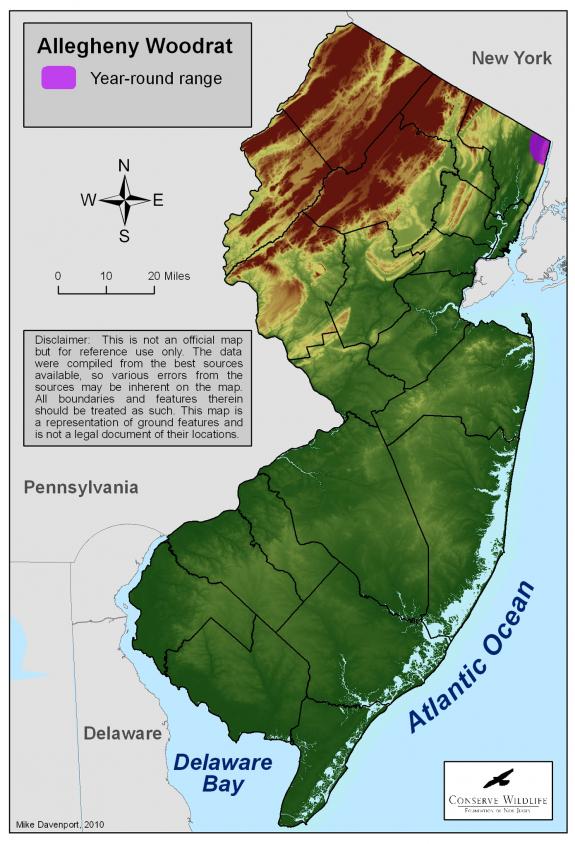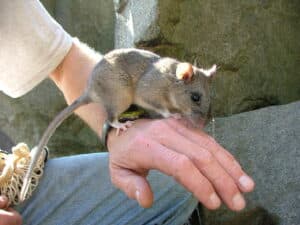Neotoma magister
Type: mammal
Status: endangered
Species Guide
Allegheny woodrat
Neotoma magister
Species Type: mammal
Conservation Status: endangered
Identification
The Allegheny woodrat is a medium-size rodent. It is most easily distinguished by its large, naked ears and its hairy, bicolor tail. The tail is dark gray above and white below. The woodrat’s new winter fur is a buff gray color heavily overlaid with black.
The fur along the midline is darker than that on the sides. The throat, belly and feet are white with creamy buff armpits (Hamilton 1963). During the winter months the fur is slightly darker and longer fading to dull gray and brownish by March. Woodrats have four toes on the front feet and five toes on the rear feet. The sexes are identical in fur color. Females have four mammae, or milk producing glands.
There is a longitudinal strip having little hair that runs the length of the abdomen. Glands located along this strip exude a strong-smelling oily pheromone during the breeding season (Poole 1940).
The head and body length in adults ranges from 8 – 9 in. The tails are shorter than the total head and body length and range from 6 – 8 in. Adult woodrats range in body weight from 7-13.5oz. (200 – 385g). Adult males are larger than females.

Distribution & Habitat
Allegheny woodrats primarily occur along the Appalachian Mountain range from the Tennessee River north through Tennessee, Kentucky, southern Indiana and Ohio, western North Carolina and Virginia, West Virginia, portions of Maryland, central and northeastern Pennsylvania, and northern New Jersey. They previously ranged into New York, but those populations have since been extirpated.
They typically occur in rocky areas associated with mountain ridges such as cliffs, caves, talus slopes and crevasses. In New Jersey, Allegheny woodrats occur in sloping fields of rock near the bases of cliffs. The most important component to the woodrats habitat is for it to provide cover. Rock outcrops must have numerous deep crevasses and overhanging rocks and ledges. The surrounding vegetation is usually deciduous forests that are comprised of oaks, birches, shrubs, and herbaceous plants. The Palisades is the site of New Jersey’s last remaining woodrat population.
Diet
The diet of the Allegheny woodrat is varied but is primarily composed of plant material. At night, they leave the security of their rocky dens to visit adjacent areas to feed on the available vegetation. Woodrats in New Jersey eat a variety of fruits, berries, tree buds, leaves, tree stems, seeds, acorns, and some other nuts. They store food in caches and are known to eat about 5% percent of their body weight in a single day. Some preferred fruit species include dogwood, blackberry, American mountain ash, wild cherries, wild grape, and Serviceberry.
Allegheny woodrats are sometimes referred to as “packrats” because of their hoarding behavior. They sometimes collect a variety of items from the environment. They have been observed collecting bones, feathers, foil, coins, nails, rubber bands, shotgun shells, and even dung from various species (Poole 1940).
Life Cycle
Allegheny woodrats are primarily nocturnal. They are active year.jpg’ound, except during extreme cold or wet weather. They construct large bulky nests deep in between rock crevasses, on rock shelves, and in caves. Their nests are always protected from the outside environment and harsh weather. Nests are open on top and are lined with sticks and fine materials, like shredded cedar bark. Food caches are usually located close to the nest and are usually used by spring.
Woodrats are generally independent of others. Dominant individuals are sometimes known to fight by using their front legs to jab their opponents head and front legs.
They breed from early spring to early fall. Woodrats normally have two litters per year. When winters are mild and food is plentiful they can have up to four litters through parts of their range. Litters range from two to six, with two being the most common. The average gestation period is 35 days.
Young woodrats are born naked and require close parental care. They begin growing hair at five days old. Their eyes open in three weeks. They are weaned from nursing when they are only four weeks old. Some young can breed within its first year of life if it was born early in the spring.
A variety of predators are known to hunt woodrats. Snakes, bobcats, foxes, weasels, hawks, and owls all prey on woodrats. Great horned owls are known to be one of the main predators of Allegheny woodrats.
Current Threats, Status, and Conservation
Current Threats, Status and Conservation

Allegheny woodrat populations have experienced declines over the past 30 years, especially in the northern part of its range. In 1984 and 1985 the Endangered and Nongame Species Program (ENSP) conducted surveys of three historic sites and 16 sites that had suitable habitat. No animals were observed. Some evidence of activity was seen at several sites.
In 1982, two new populations of Allegheny woodrats were discovered in New Jersey. Only one site remains today at the Palisades. The Allegheny woodrat was listed as an endangered species in 1991.
The Palisades population has been monitored by live trapping since the mid-1980s. Trapping results indicate that the population has remained stable over the past several years.
The rapid decline of Allegheny woodrat populations throughout the northern portion of its range has caused much concern about the species’ future. Research has involved treating raccoons for a parasitic nematode (raccoon roundworm), that can be fatal to woodrats. Treated bait is released around woodrat sites to help reduce mortality that is associated with this cause. This technique may provide an effective means of reducing the threat of this parasite in woodrat populations.
Live trapping surveys are conducted annually each fall by ENSP biologists. Results have indicated that the Palisades population has remained stable and may be increasing slightly. Annual surveys are critical to help determine the health of the only remaining population in New Jersey to avoid extirpation.
Current threats to Allegheny woodrats include declines in food sources from Gypsy moth infestations and bad seed years, habitat loss and fragmentation, and mortality from roundworms carried by raccoons. It is believed that the combination of all of these threats have caused the woodrat to become endangered or threatened throughout most of its range.
References
- Hamilton, W.J., Jr. 1963. The Mammals of the Eastern United States. New York: Hafner.
- Hicks, A.P. 1989. Whatever happened to the Allegheny woodrat? New York State Conservationist, March-April 1989, 34-38.
- Poole, E.L. 1940. A life history sketch of the Allegheny woodrat. J. Mammal. 21:249-318.
Text derived from the book, Endangered and Threatened Wildlife of New Jersey. 2003. Originally written by Michael Valent. Originally edited by B.E. Beans & L. Niles. Edited and updated in 2010 by Ben Wurst.
Scientific Classification
- Kingdom: Animalia
- Phylum: Chordata
- Class: Mammalia
- Order: Rodentia
- Family: Cricetidae
- Genus: Neotoma
- Species: N. magister